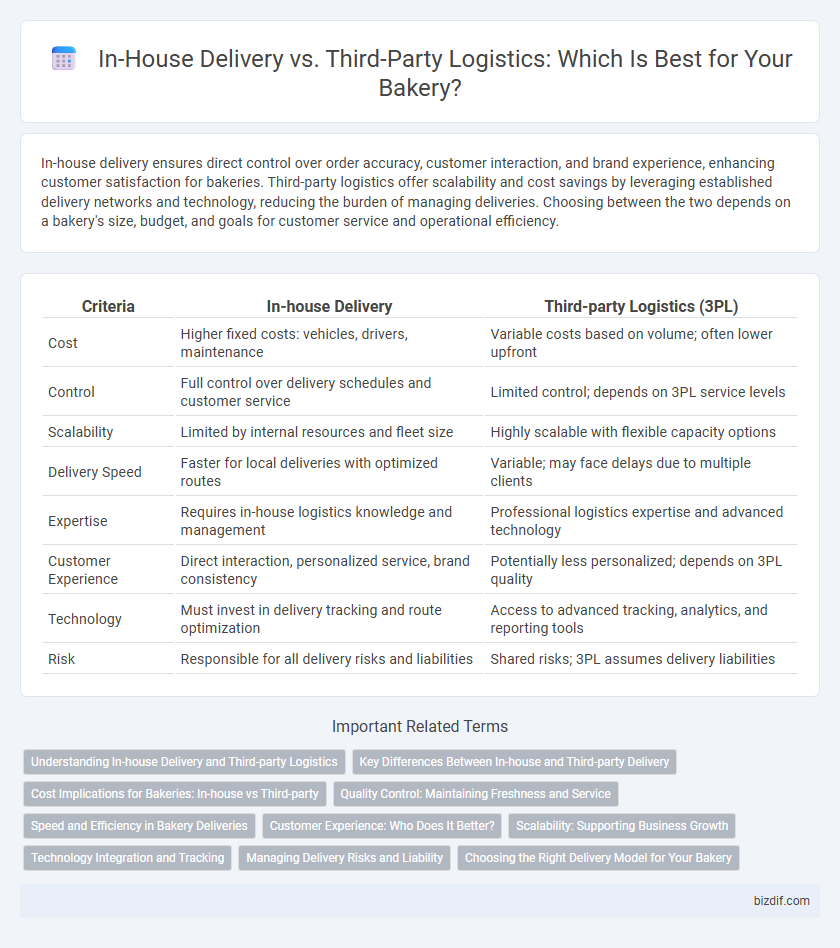In-house delivery ensures direct control over order accuracy, customer interaction, and brand experience, enhancing customer satisfaction for bakeries. Third-party logistics offer scalability and cost savings by leveraging established delivery networks and technology, reducing the burden of managing deliveries. Choosing between the two depends on a bakery's size, budget, and goals for customer service and operational efficiency.
Table of Comparison
| Criteria | In-house Delivery | Third-party Logistics (3PL) |
|---|---|---|
| Cost | Higher fixed costs: vehicles, drivers, maintenance | Variable costs based on volume; often lower upfront |
| Control | Full control over delivery schedules and customer service | Limited control; depends on 3PL service levels |
| Scalability | Limited by internal resources and fleet size | Highly scalable with flexible capacity options |
| Delivery Speed | Faster for local deliveries with optimized routes | Variable; may face delays due to multiple clients |
| Expertise | Requires in-house logistics knowledge and management | Professional logistics expertise and advanced technology |
| Customer Experience | Direct interaction, personalized service, brand consistency | Potentially less personalized; depends on 3PL quality |
| Technology | Must invest in delivery tracking and route optimization | Access to advanced tracking, analytics, and reporting tools |
| Risk | Responsible for all delivery risks and liabilities | Shared risks; 3PL assumes delivery liabilities |
Understanding In-house Delivery and Third-party Logistics
In-house delivery allows bakeries to maintain full control over order fulfillment, ensuring product freshness and brand consistency through direct handling by trained staff. Third-party logistics (3PL) providers offer scalable solutions with established distribution networks, reducing operational complexity and expanding delivery reach beyond local markets. Choosing between in-house delivery and 3PL depends on factors such as delivery volume, geographic coverage, cost efficiency, and the importance of customer experience in timely bakery product delivery.
Key Differences Between In-house and Third-party Delivery
In-house delivery in a bakery allows for greater control over order accuracy, freshness, and customer service, ensuring a consistent brand experience. Third-party logistics (3PL) offers expanded delivery reach and reduced overhead costs by leveraging established networks and technology platforms. Key differences include cost structure, scalability, quality control, and customer interaction, with in-house delivery requiring internal resource management and 3PL focusing on outsourcing efficiency.
Cost Implications for Bakeries: In-house vs Third-party
In-house delivery for bakeries often reduces costs by eliminating third-party fees and offering direct control over scheduling and routes, though it requires investment in vehicles, drivers, and insurance. Third-party logistics (3PL) can increase expenses through service charges and markups but minimizes overhead by outsourcing delivery responsibilities and leveraging established distribution networks. Careful cost analysis should include labor, fuel, vehicle maintenance, and potential service scalability when choosing between in-house delivery and third-party logistics for bakery operations.
Quality Control: Maintaining Freshness and Service
In-house delivery ensures tighter quality control by allowing bakeries to directly oversee the handling and timely distribution of fresh products, preserving optimal taste and texture. Third-party logistics can introduce variables that risk delays or improper storage, potentially compromising product freshness and customer satisfaction. Maintaining freshness through in-house delivery supports consistent service standards and reinforces brand reputation for quality.
Speed and Efficiency in Bakery Deliveries
In-house delivery in bakery operations ensures faster order processing and personalized handling, directly controlling speed and minimizing delays from order placement to customer receipt. Third-party logistics offer scalability and extensive delivery networks but may introduce variability in delivery times due to external coordination and prioritization challenges. Efficient bakery deliveries rely on balancing the immediacy of in-house control with the expansive reach of third-party services to meet customer expectations for freshness and timely arrival.
Customer Experience: Who Does It Better?
In-house delivery enables bakeries to maintain full control over order accuracy, packaging quality, and timely service, directly impacting customer satisfaction and brand loyalty. Third-party logistics offer scalability and wider reach but may compromise the personalized touch and consistency essential for gourmet baked goods. Evaluating customer feedback reveals that bakeries with dedicated delivery teams often receive higher ratings for freshness and customer service compared to those relying on third-party platforms.
Scalability: Supporting Business Growth
In-house delivery offers bakers direct control over delivery quality and customer experience but may struggle to scale quickly during demand spikes or expansion into new areas. Third-party logistics providers offer scalable solutions with established networks and technology, enabling bakeries to efficiently manage larger volumes and broaden their geographic reach without heavy investment. Leveraging third-party delivery services allows bakeries to focus on production and innovation while meeting growing customer expectations for timely, reliable order fulfillment.
Technology Integration and Tracking
In-house delivery systems in bakeries benefit from seamless technology integration tailored to specific operational workflows, allowing real-time tracking of orders and enhanced customer communication through proprietary apps. Third-party logistics providers offer advanced, scalable tracking platforms compatible with multiple retailers, yet may lack customization for bakery-specific needs and immediate feedback loops. Implementing GPS-enabled delivery tracking combined with automated dispatch systems significantly improves order accuracy and delivery times in both models, impacting overall customer satisfaction.
Managing Delivery Risks and Liability
Managing delivery risks and liability in bakery operations requires careful evaluation of in-house delivery versus third-party logistics (3PL). In-house delivery enables direct control over product handling, ensuring freshness and reducing damage risks, but increases responsibility for liability and operational costs. Third-party logistics shifts liability risks to specialized carriers with established protocols, though bakeries must rigorously verify 3PL compliance and insurance coverage to protect brand reputation and customer satisfaction.
Choosing the Right Delivery Model for Your Bakery
Selecting the right delivery model for your bakery involves evaluating factors such as cost efficiency, control over customer experience, and scalability. In-house delivery allows direct management of order quality and timing, enhancing brand loyalty through personalized service, while third-party logistics offer broader reach and reduced operational complexity. Balancing these priorities ensures optimal fulfillment, customer satisfaction, and sustainable growth in the competitive bakery market.
In-house Delivery vs Third-party Logistics Infographic

 bizdif.com
bizdif.com